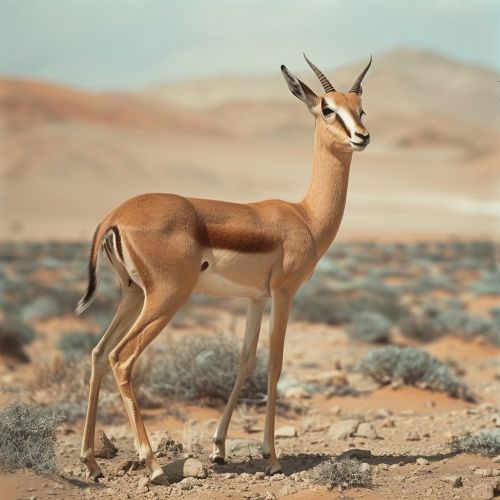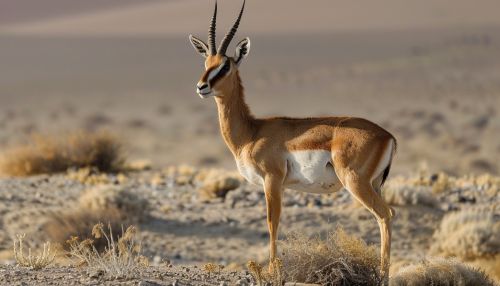Gazella dorcas
Taxonomy and Classification
The Dorcas gazelle (Gazella dorcas) is a species of gazelle that is widely distributed across North Africa and parts of the Middle East. It belongs to the family Bovidae and the genus Gazella. The species was first described by Carl Linnaeus in 1758. The Dorcas gazelle is closely related to other species within the genus, such as the mountain gazelle (Gazella gazella) and the Cuvier's gazelle (Gazella cuvieri).
Physical Description
Dorcas gazelles are small to medium-sized antelopes, with a body length ranging from 90 to 110 cm and a shoulder height of 55 to 65 cm. They typically weigh between 15 and 20 kg. The coat is pale fawn or sandy in color, providing excellent camouflage in their arid habitats. A distinctive white stripe runs along the flanks, separating the darker upper parts from the white underparts. Both males and females possess horns, although the horns of males are longer and more robust, measuring up to 40 cm in length. The horns are lyre-shaped, with prominent ridges.


Distribution and Habitat
Dorcas gazelles inhabit a wide range of arid and semi-arid environments, including deserts, steppes, and savannas. Their distribution extends from Morocco and Mauritania in the west, across the Sahara Desert, to Egypt and Sudan in the east, and into the Arabian Peninsula. They are well-adapted to extreme conditions, capable of surviving without direct water sources for extended periods. Instead, they obtain moisture from the vegetation they consume, such as acacia leaves, grasses, and herbs.
Behavior and Ecology
Dorcas gazelles are primarily crepuscular, being most active during the early morning and late afternoon to avoid the intense midday heat. They are highly social animals, typically forming small herds of up to 20 individuals, although larger aggregations can occur in areas with abundant resources. The social structure is usually composed of a dominant male, several females, and their offspring. Males are territorial and will defend their home ranges from rivals through displays of aggression and scent marking.
Diet
The diet of the Dorcas gazelle is primarily herbivorous, consisting of a variety of grasses, leaves, and shoots. During the dry season, they may rely more heavily on browse, including the leaves and pods of acacia trees. Their ability to extract sufficient moisture from their food allows them to thrive in environments where water is scarce.
Reproduction
Breeding in Dorcas gazelles typically occurs during the cooler months, from September to November. After a gestation period of approximately six months, females give birth to a single calf, although twins are occasionally reported. The newborns are well-developed at birth and are able to stand and move within a few hours. Calves remain hidden in vegetation for the first few weeks of life, reducing the risk of predation.
Conservation Status
The Dorcas gazelle is currently listed as Vulnerable on the IUCN Red List of Threatened Species. The primary threats to their survival include habitat loss due to agricultural expansion, hunting for meat and trophies, and competition with domestic livestock. Conservation efforts are underway in several countries, including the establishment of protected areas and captive breeding programs.
Cultural Significance
Dorcas gazelles have been depicted in ancient art and literature, particularly in Egyptian and Mesopotamian cultures. They were often associated with deities and were considered symbols of grace and beauty. In modern times, they continue to hold cultural significance in the regions they inhabit, often featured in folklore and traditional stories.
See Also
References
- Mallon, D.P. & Kingswood, S.C. (2001). Antelopes: Global Survey and Regional Action Plans. IUCN.
- IUCN SSC Antelope Specialist Group (2016). Gazella dorcas. The IUCN Red List of Threatened Species 2016.
